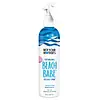What's inside
What's inside
 Key Ingredients
Key Ingredients

 Benefits
Benefits

 Concerns
Concerns

 Ingredients Side-by-side
Ingredients Side-by-side

Water
Skin ConditioningAloe Barbadensis Leaf Juice
Skin ConditioningSd Alcohol 40-B
AstringentRosa Damascena Flower Water
MaskingPolysorbate 20
EmulsifyingGlycerin
HumectantPolyquaternium-11
Polyquaternium-16
Heptyl Undecylenate
EmollientRosa Canina Fruit Extract
AstringentCamellia Sinensis Leaf Extract
AntimicrobialAcacia Senegal Gum
MaskingXylitol
HumectantCoconut Alkanes
EmollientCoco-Caprylate/Caprate
EmollientHydrolyzed Quinoa
Skin ConditioningHydrolyzed Wheat Protein
Skin ConditioningTriticum Vulgare Starch
AbrasiveCetrimonium Chloride
AntimicrobialGalactoarabinan
Sodium Hyaluronate
HumectantHydrolyzed Silk
HumectantTocopheryl Acetate
AntioxidantVp/Va Copolymer
Phenoxyethanol
PreservativeBenzyl Alcohol
PerfumingPotassium Sorbate
PreservativeSodium Benzoate
MaskingIsopropyl Alcohol
SolventLaurtrimonium Chloride
EmulsifyingSodium Bisulfite
AntioxidantPelargonium Graveolens Oil
MaskingRosa Damascena Flower Oil
MaskingLavandula Angustifolia Oil
MaskingBoswellia Carterii Oil
MaskingCananga Odorata Flower Oil
MaskingBenzyl Benzoate
AntimicrobialCitronellol
PerfumingLimonene
PerfumingGeraniol
PerfumingLinalool
PerfumingWater, Aloe Barbadensis Leaf Juice, Sd Alcohol 40-B, Rosa Damascena Flower Water, Polysorbate 20, Glycerin, Polyquaternium-11, Polyquaternium-16, Heptyl Undecylenate, Rosa Canina Fruit Extract, Camellia Sinensis Leaf Extract, Acacia Senegal Gum, Xylitol, Coconut Alkanes, Coco-Caprylate/Caprate, Hydrolyzed Quinoa, Hydrolyzed Wheat Protein, Triticum Vulgare Starch, Cetrimonium Chloride, Galactoarabinan, Sodium Hyaluronate, Hydrolyzed Silk, Tocopheryl Acetate, Vp/Va Copolymer, Phenoxyethanol, Benzyl Alcohol, Potassium Sorbate, Sodium Benzoate, Isopropyl Alcohol, Laurtrimonium Chloride, Sodium Bisulfite, Pelargonium Graveolens Oil, Rosa Damascena Flower Oil, Lavandula Angustifolia Oil, Boswellia Carterii Oil, Cananga Odorata Flower Oil, Benzyl Benzoate, Citronellol, Limonene, Geraniol, Linalool
 Reviews
Reviews

Ingredients Explained
These ingredients are found in both products.
Ingredients higher up in an ingredient list are typically present in a larger amount.
Benzyl Alcohol is most commonly used as a preservative. It also has a subtle, sweet smell. Small amounts of Benzyl Alcohol is not irritating and safe to use in skincare products. Most Benzyl Alcohol is derived from fruits such as apricots.
Benzyl Alcohol has both antibacterial and antioxidant properties. These properties help lengthen the shelf life of products. Benzyl Alcohol is a solvent and helps dissolve other ingredients. It can also improve the texture and spreadability.
Alcohol comes in many different forms. Different types of alcohol will have different effects on skin. This ingredient is an astringent alcohol.
Using high concentrations of these alcohols are drying on the skin. They may strip away your skin's natural oils and even damage your skin barrier. Astringent alcohols may also irritate skin.
Other types of astringent alcohols include:
According to the National Rosacea Society based in the US, you should be mindful of products with these alcohols in the top half of ingredients.
Any type of sanitizing product will have high amounts of alcohol to help kill bacteria and viruses.
Learn more about Benzyl AlcoholPhenoxyethanol is a preservative that has germicide, antimicrobial, and aromatic properties. Studies show that phenoxyethanol can prevent microbial growth. By itself, it has a scent that is similar to that of a rose.
It's often used in formulations along with Caprylyl Glycol to preserve the shelf life of products.
Polysorbate 20 is made by combining ethoxylation of sorbitan, ethylene oxide, and lauric acid. It is a mild cleansing agent, surfactant, and emulsifier.
As a surfactant, it helps collect dirt and oils for washing. Emulsifiers prevent oils and water from separating.
Polysorbate 20 also adds scent to a product. Since it is made using sorbitol, it has a sweet scent. Sorbitol can also be found in fruits such as apples and peaches.
The lauric acid used to create Polysorbate 20 is often derived from coconuts.
Polysorbate 20 may not be fungal acne safe.
Learn more about Polysorbate 20Sodium Benzoate is a preservative. It's used in both cosmetic and food products to inhibit the growth of mold and bacteria. It is typically produced synthetically.
Both the US FDA and EU Health Committee have approved the use of sodium benzoate. In the US, levels of 0.1% (of the total product) are allowed.
Sodium benzoate works as a preservative by inhibiting the growth of bacteria inside of cells. It prevents the cell from fermenting a type of sugar using an enzyme called phosphofructokinase.
It is the salt of benzoic acid. Foods containing sodium benzoate include soda, salad dressings, condiments, fruit juices, wines, and snack foods.
Studies for using ascorbic acid and sodium benzoate in cosmetics are lacking, especially in skincare routines with multiple steps.
We always recommend speaking with a professional, such as a dermatologist, if you have any concerns.
Learn more about Sodium BenzoateWater. It's the most common cosmetic ingredient of all. You'll usually see it at the top of ingredient lists, meaning that it makes up the largest part of the product.
So why is it so popular? Water most often acts as a solvent - this means that it helps dissolve other ingredients into the formulation.
You'll also recognize water as that liquid we all need to stay alive. If you see this, drink a glass of water. Stay hydrated!
Learn more about Water